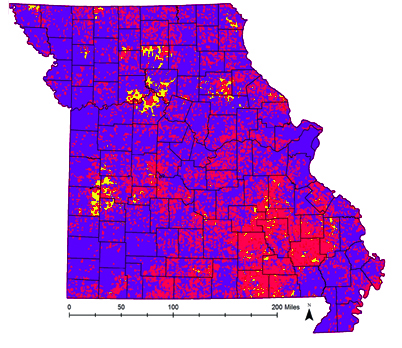Missouri broadband summit
 The theme of this year’s Missouri Broadband Summit was “Breaking New Ground.” Judging by some of the presentations, that process will require plenty of out-of-the-box thinking when it comes to funding high-speed networks and then convincing people and businesses to sign up.
The theme of this year’s Missouri Broadband Summit was “Breaking New Ground.” Judging by some of the presentations, that process will require plenty of out-of-the-box thinking when it comes to funding high-speed networks and then convincing people and businesses to sign up.
Held Nov. 17 in Jefferson City, the second-annual event centered around MoBroadbandNow, a state initiative that aims to increase broadband accessibility from about 79 percent today to 95 percent by the end of 2014. So far, the initiative has helped attract $261 million in grants and loans for 19 projects, including for two Columbia-based companies: BlueBird Media and Socket Telecom.
“Over the next few years, Missouri will see a minimum of $311 million in MoBroadbandNow projects,” Gov. Jay Nixon said. “That doesn’t count the partners with it. That doesn’t count a lot of last-mile, private-sector investments. That doesn’t count the infrastructure investments that are being made by large organizations.”
The summit included updates on MoBroadbandNow’s ongoing project to map changes in the state’s broadband penetration and survey consumers and businesses about the cost, speed and availability of Internet access in their communities.
“Is it more of an adoption gap? Is it an availability gap?” said Tim Haithcoat, who leads the MoBroadbandNow map project. “What we’ve been tracking so far is on the availability side, but we really need to start addressing is the adoption side. That’s where we’re headed in the future.”
Show Me the money
To maintain the current momentum, municipalities will have to be flexible and creative when it comes to creating partnerships with broadband providers. Blair Levin, executive director of the Gig.U project that includes the University of Missouri and other educational institutions, cited the city of Seattle’s decision to provide access to 500 miles of city-owned fiber as an example of how governments can reduce construction and other overhead costs for private companies that want to build networks capable of 1 gigabyte per second (Gbps) or faster.
Lower overhead costs also should enable operators to price their broadband services at a point that more businesses and consumers can afford. That’s critical because in Columbia and other cities, 1 Gbps services are already available — just not at prices that most potential customers can justify.
“The bottom line is that we’re running a business,” said Craig Settles, an Oakland, Calif.-based consultant who specializes in broadband. “If the business does not generate revenues to sustain its operations, then we will fail. All of the good things we want to do will not happen unless we make these projects financially sustainable.”
One cautionary tale is the municipal Wi-Fi craze circa 2005, when hundreds of cities and counties across the country sought to blanket themselves with wireless service by partnering with private companies that would build and operate the networks. Many of those projects failed because the business models were based on overly optimistic revenue assumptions, such as the ability to sell enough online advertising to cover the cost of operating the network.
Settles blamed those flame-outs partly on government requests for information and proposals (RFIs and RFPs), which limited private partners’ revenue opportunities in some cases and forced them to take on too much financial risk in others.
“Governments put private-sector companies in straight jackets,” Settles said. “As a community, you cannot find good partners if you do not first think about what makes this deal a winner for them.”
As an example, Settles cited Ontario County, N.Y., which used bonds to fund a network because it could spread the payments over 25 years, a payback period too long for private companies. Operators such as Verizon Communications now deliver service over the county-owned network.
Preaching the gospel of broadband
Municipalities and the state also need to scrutinize regulations, permitting processes and other bureaucratic hoops, Settles said. Those can dissuade potential partners by increasing network construction costs and delaying time to revenue. Streamlining those processes is particularly important — but also difficult — when multiple jurisdictions are involved, such as a multicounty broadband rollout.
“One of the things Google said when they were deciding which communities to consider was the regulatory environment,” Settles said. “Are there a bunch of silly little laws dating back 30 years that will prohibit us from moving forward? Or is the community willing to look at its laws and to think in the 21st century? You have to make this process easy.”
Another type of partnership also can spur adoption. Settles suggested that municipalities and network operators work with health care providers, colleges, banks and other organizations that already interact with consumers on a daily basis. Those organizations can educate their customers about how signing up for broadband will improve their lives, for example, by enabling video calls with their physician instead of trekking to the doctor’s office.
“It resonates with the prospective subscriber,” Settles said. “It gives them a reason to be online.”
In the process, the broadband provider avoids much of the cost of signing up customers.
“The medical facility now has taken a lot of the marketing burden off of your shoulders and the expense,” Settles said. “They’re now marketing for you. If your partners are preaching the gospel of broadband, that’s going to drive adoption of your network. It’s going to drive your financial sustainability.”


